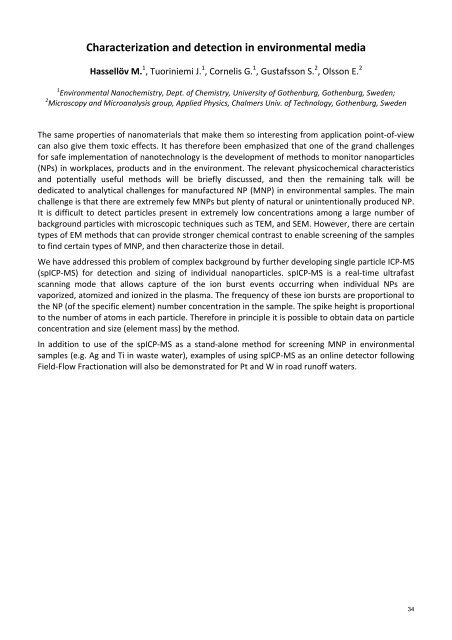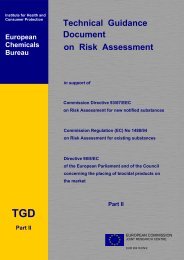Challenges of Regulation and Risk Assessment of Nanomaterials
Challenges of Regulation and Risk Assessment of Nanomaterials
Challenges of Regulation and Risk Assessment of Nanomaterials
You also want an ePaper? Increase the reach of your titles
YUMPU automatically turns print PDFs into web optimized ePapers that Google loves.
Characterization <strong>and</strong> detection in environmental media<br />
Hassellöv M. 1 , Tuoriniemi J. 1 , Cornelis G. 1 , Gustafsson S. 2 , Olsson E. 2<br />
1 Environmental Nanochemistry, Dept. <strong>of</strong> Chemistry, University <strong>of</strong> Gothenburg, Gothenburg, Sweden;<br />
2 Microscopy <strong>and</strong> Microanalysis group, Applied Physics, Chalmers Univ. <strong>of</strong> Technology, Gothenburg, Sweden<br />
The same properties <strong>of</strong> nanomaterials that make them so interesting from application point-<strong>of</strong>-view<br />
can also give them toxic effects. It has therefore been emphasized that one <strong>of</strong> the gr<strong>and</strong> challenges<br />
for safe implementation <strong>of</strong> nanotechnology is the development <strong>of</strong> methods to monitor nanoparticles<br />
(NPs) in workplaces, products <strong>and</strong> in the environment. The relevant physicochemical characteristics<br />
<strong>and</strong> potentially useful methods will be briefly discussed, <strong>and</strong> then the remaining talk will be<br />
dedicated to analytical challenges for manufactured NP (MNP) in environmental samples. The main<br />
challenge is that there are extremely few MNPs but plenty <strong>of</strong> natural or unintentionally produced NP.<br />
It is difficult to detect particles present in extremely low concentrations among a large number <strong>of</strong><br />
background particles with microscopic techniques such as TEM, <strong>and</strong> SEM. However, there are certain<br />
types <strong>of</strong> EM methods that can provide stronger chemical contrast to enable screening <strong>of</strong> the samples<br />
to find certain types <strong>of</strong> MNP, <strong>and</strong> then characterize those in detail.<br />
We have addressed this problem <strong>of</strong> complex background by further developing single particle ICP-MS<br />
(spICP-MS) for detection <strong>and</strong> sizing <strong>of</strong> individual nanoparticles. spICP-MS is a real-time ultrafast<br />
scanning mode that allows capture <strong>of</strong> the ion burst events occurring when individual NPs are<br />
vaporized, atomized <strong>and</strong> ionized in the plasma. The frequency <strong>of</strong> these ion bursts are proportional to<br />
the NP (<strong>of</strong> the specific element) number concentration in the sample. The spike height is proportional<br />
to the number <strong>of</strong> atoms in each particle. Therefore in principle it is possible to obtain data on particle<br />
concentration <strong>and</strong> size (element mass) by the method.<br />
In addition to use <strong>of</strong> the spICP-MS as a st<strong>and</strong>-alone method for screening MNP in environmental<br />
samples (e.g. Ag <strong>and</strong> Ti in waste water), examples <strong>of</strong> using spICP-MS as an online detector following<br />
Field-Flow Fractionation will also be demonstrated for Pt <strong>and</strong> W in road run<strong>of</strong>f waters.<br />
34








